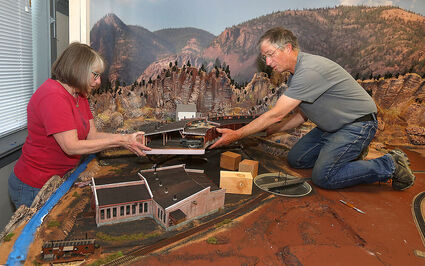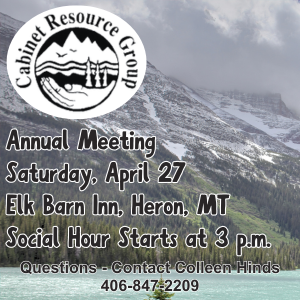Roundhouse installed in Paradise display
July 14, 2022

Ed Moreth
CAREFUL – Judi and Terry Christensen lower a section of the roundhouse at the Paradise Center's railroad display.
It was more than three years in the making, but now it's a dominant part of the Paradise Center's railroad display.
Terry Christensen of Plains began working on the model roundhouse in January 2019 and two weeks ago he and his wife, Judi, installed the 62-inch long roundhouse on a 35-foot display table that had been constructed five years ago with a special spot for the roundhouse.
"The geometry had to be perfect. I was nervous about that in the beginning, but it's much better than I expected," said Christensen. It took three and a half hours to get the structure into place. Holes were cut into the table for the electrical wiring. He had created the landscaping around the roundhouse in April. He made the landscaping ahead of time because he knew it couldn't be done once the roundhouse was in place.
The roundhouse was in two parts. The first smaller section went in without a hitch, but it took them three threes to get the larger section installed. Twice it had to be lifted back out to cut away part of the foam board to get the building to fit.
"It was quite a challenge," said Christensen, who was pleased to finally have the project complete. The model, which cost the Paradise Center $900, was a kit, but Christensen said he had to do a lot of tweaking to get pieces to fit and even had to construct parts in order to duplicate the roundhouse at Paradise, which was in service from 1907 to 1937. The model depicts the roundhouse of the mid 1930s.
"We had to do a lot more research on it to get it correct. I wanted this to be as historically accurate as possible. That was important to me," said Christensen, who found information on the Paradise roundhouse in books, model railroad magazines, and the Internet. Christensen said he had to customize about 50% of the kit.
He went to Google Earth to get an aerial photograph of where the actual roundhouse had been located. In the satellite images, he could make out the form of the building, which had gone across where Highway 200 is located today. "It's amazing. You can still see today where the service bay tracks were located," said Christensen, who had a printout made and added it to the railroad exhibit interpretative panels. "We had to do a lot more research on it to get it correct," he said.
"The quality of the work on the roundhouse is excellent. That was a museum rated kit and the outcome shows it was done by someone who is way more advanced than a average train modeler," said Dave Colyer, president of the Paradise Center and one of more than a dozen volunteers working on the railroad display, located on the centers main floor. One of Christensen's goals was to have it in place before the Paradise School reunion the previous week, which he did. Colyer, a school alumni, said he received several positive comments from those attending the reunion. Part of the funding for the project came from a grant from the Northern Pacific Railway Historic Association and also from donations specifically for the railroad exhibit, said Karen Thorson, the center's secretary.
The display is on two custom made tables designed and made by Rudi Boukal of Thompson Falls, along with over 70 feet of track, and several buildings representing railroad operations and the town. Mac Hall of Plains, a model railroader for more than 40 years, is heading the project and believes it will likely be done in about two years. The roundhouse presently is the main structure on the table that will eventually show the town and Paradise Elementary School, now the center.
Christensen has about 750 hours into the model, which was actually seven kits of three engine stalls each. Judi helped with much of it, putting some 100 hours into the project. She converted a tiny toy Model T truck kit into a McGowan Grocery delivery truck and placed 10 bighorn sheep on a mountain ledge behind the roundhouse. Christensen said the roundhouse weighs only about 10 pounds, but it is extremely fragile with thousands of parts, some that measure only a fraction of an inch.
The kit had 10 pages of instructions, although Christensen worked mostly from one page, which the modeler made from the actual blueprints of a roundhouse. He called the model designer, Clint Crow of Mukilteo, Washington, numerous times for assistance. Crow also sent him extra materials to help with the project at no extra cost. Christensen also got some help from Katherine Maudrone and Dawn Gandalf, who worked on the roundhouse's 100 small windows and the chimneys.
The 66-year-old Christensen worked on the project only during the winter months when he wasn't working on his Plains home, which he built from scratch, using tools of the 1880s for the frame of the house. Christensen has been into model railroading since he was 6 years old and he was a mechanical engineer for 16 years.
Christensen went the extra mile to make the roundhouse more authentic looking. He added workers that were replacing a portion of the roof that caught fire. "There's no record of a fire at the Paradise roundhouse, but they had fires all the time, so I took the liberty of adding a piece that looks like there was a fire and they're fixing the roof," said Christensen, who said that the people figurines add scale and life to the model. In the work area are ladders that were made by Judi. He made a removable roof and inside are people working on one of five locomotives inside the roundhouse.
Christensen built a temporary structure behind the roundhouse where eventually the "Cliff House," a building that was used to house Northern Pacific Railroad locomotive crews, will be placed. Judi will be making the actual building.
He found only one low quality photograph of the Paradise roundhouse that he guesses is from the 1920s, and based on that image, he added a loading dock and a shop to the model. Christensen was able to find a brick from the actual roundhouse, which he used to match the color of some of the outside walls. In addition, he found out there was a tale of an old locomotive that had derailed and went into the Clark Fork River sometime in the early 1900s. It is said to have been left imbedded in the water and mud, though there is no concrete evidence of the derailment. Nevertheless, Christensen had an HO scale train engine and made a small pond next to the tracks where he put the engine, partially submerged.
The Plains man also created a museum quality light and sound system for the roundhouse and installed a motion sensor so that when a visitor approached the display a narrative that he recorded would come on to explain the facility. He also added traditional railroad sounds.
Christensen's next project for the railroad display is making a boiler and engine room building, something he hopes to have done next winter. There's a possibility that he might be the one constructing the Paradise Elementary School building. He said it won't be as detailed as the roundhouse and might take only one winter to get done. The schoolhouse will have to be done by scratch, but Christensen has already started researching it. He said there are no blueprints available, but there are floor plans. What will be useful is that the building is still there and hasn't changed much since it was erected in 1910.
Christensen said that even though it took years to get the roundhouse done, he said it was fun and he felt it was a rewarding endeavor. "It has a lot of detail, but I like that. I'm a detail person," said Christensen. "It was quite a long project, but it was a relief to get it done," he said. "It was daunting at first, but it all came together in the end."
The display roundhouse isn't the first roundhouse in Paradise and won't be the last. The center is planning to build a "mini roundhouse" located outside along the Paradise Center Walking Trail. Thorson said the original estimate for the 27-foot long roundhouse was $54,000, and even though the center recieved $30,000 from the Office of Tourism and $5000 from the National Railway Historical Society Heritage Grant, she said they are looking at other funding possibilities. "We may build the structure in stages depending on available funding," she added.







Reader Comments(0)